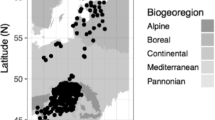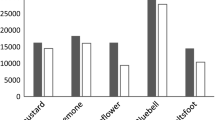Abstract
The importance of long-term plant phenological time series is growing in monitoring of climate change impacts worldwide. To detect trends and assess possible influences of climate in Hungary, we studied flowering phenological records for six species (Convallaria majalis, Taraxacum officinale, Syringa vulgaris, Sambucus nigra, Robinia pseudoacacia, Tilia cordata) based on phenological observations from the Hungarian Meteorological Service recorded between 1952 and 2000. Altogether, four from the six examined plant species showed significant advancement in flowering onset with an average rate of 1.9–4.4 days per decade. We found that it was the mean temperature of the 2–3 months immediately preceding the mean flowering date, which most prominently influenced its timing. In addition, several species were affected by the late winter (January–March) values of the North Atlantic Oscillation (NAO) index. We also detected sporadic long-term effects for all species, where climatic variables from earlier months exerted influence with varying sign and little recognizable pattern: the temperature/NAO of the previous autumn (August-December) seems to influence Convallaria, and the temperature/precipitation of the previous spring (February–April) has some effect on Tilia flowering.


Similar content being viewed by others
References
Abdi H (2007) Bonferroni and Šidák corrections for multiple comparisons. In: Salkind N (ed) Encyclopedia of measurement and statistics. Sage, Thousand Oaks, CA
Askeyev OV, Sparks TH, Askeyev IV, Tishin DV, Tryjanowski P (2010) East versus West: contrasts in phenological patterns? Glob Ecol Biogeogr 19:783–793
Bartholy J, Pongrácz R, Gelybó G (2009a) Climate signals of the North Atlantic Oscillation detected in the Carpathian basin. Appl Ecol Environ Res 7:229–240
Bartholy J, Pongrácz R, Torma C, Pieczka I, Kardos P, Hunyady A (2009b) Analysis of regional climate change modelling experiments for the Carpathian Basin. Int J Glob Warming 1:238–252
Beebee TJC (2002) Amphibian phenology and climate change. Conserv Biol 16:1454–1454
Both C, Van Asch M, Bijlsma RG, Van Den Burg AB, Visser ME (2009) Climate change and unequal phenological changes across four trophic levels: constraints or adaptations? J Anim Ecol 78:73–83
Buse A, Dury SJ, Woodburn RJW, Perrins CM, Good JEG (2002) Effects of elevated temperature on multi-species interactions: the case of Pedunculate Oak, Winter Moth and Tits. Funct Ecol 13:74–82
Chmielewski FM, Rötzer T (2001) Response of tree phenology to climate change across Europe. Agric For Meteorol 108:101–112
Cook BI, Wolkovich EM, Parmesan C (2012) Divergent responses to spring and winter warming drive community level flowering trends. Proc Natonal Acad Sci U S A 109:9000–9005
Crimmins TM, Crimmins MA, Bertelsen D (2010) Complex responses to climate drivers in onset of spring flowering across a semi-arid elevation gradient. J Ecol 98:1042–1051
Dose V, Menzel A (2004) Bayesian analysis of climate change impacts in phenology. Glob Chang Biol 10:259–272
Dövényi Z (2010) Magyarország kistájainak katasztere. MTA FKI, Budapest (in hungarian)
Dunay S (1984) Növényfenológiai megfigyelések Magyarországon. Légkör 29:2–9 (in hungarian)
Estrella N, Sparks TH, Menzel A (2007) Trends and temperature response in the phenology of crops in Germany. Glob Chang Biol 13:1737–1747
Fitter AH, Fitter RSR (2002) Rapid changes in flowering time in British plants. Science 296:1689–1691
Fu YH, Piao S, Zhao H, Jeong S-J, Wang X, Vitasse Y, Ciais P, Janssens IA (2014) Unexpected role of winter precipitation in determining heat requirement for spring vegetation green-up at northern middle and high latitudes. Glob Chang Biol 12:3743–3755
Gordo O (2007) Why are bird migration dates shifting? A review of weather and climate effects on avian migratory phenology. Clim Res 35:37–58
Gordo O, Sanz J (2010) Impact of climate change on plant phenology in Mediterranean ecosystems. Glob Chang Biol 16:1082–1106
Hurrel JW, van Loon H (1997) Decadal variations in climate associated with the North Atlantic Oscillation. Clim Chang 36:301–326
IPCC (2007) Climate Change 2007 - Impacts, Adaptation and Vulnerability: Contribution of Working Group II to the Fourth Assessment Report of the IPCC. Cambridge University Press, Cambridge
Jatczak K, Walawender J (2009) Average rate of phenological changes in Poland according to climatic changes—evaluation and mapping. Adv Sci Res 3:127–131
Johnson JB, Omland KS (2004) Model selection in ecology and evolution. Trends Ecol Evol 19:101–108
Kauserud H, Heegaard E, Semenov MA, Boddy L, Halvorsen R, Stige LC, Sparks TH, Gange AC, Stenseth NC (2010) Climate change and spring-fruiting fungi. Proc R Soc Biol 277:1169–1177
Keresztes B (1984) Az akác (Robinia pseudoacacia L). Akadémia Kiadó, Budapest (in hungarian)
Körner C, Basler D (2010) Phenology under global warming. Science 327:1461–1462
Krüzselyi I, Bartholy J, Horányi A, Pieczka I, Pongrácz R, Szabó P, Szépszó G, Cs T (2011) The future climate characteristics of the Carpathian Basin based on a regional climate model mini-ensemble. Adv Sci Res 6:69–73
López-Moreno JI, Vicente-Serrano SM, Morán-Tejeda E, Lorenzo-Lacruz J, Kenawy A, Beniston M (2011) Effects of the North Atlantic Oscillation (NAO) on combined temperature and precipitation winter modes in the Mediterranean mountains: Observed relationships and projections for the 21st century. Glob Planet Chang 77:62–76
Meier U (1997) BBCH-Monograph: Growth stages of mono- and dicotyledonous plants. Blackwell Wissenschafts-Verlag, Berlin
Memmott J, Craze PG, Waser NM, Price MV (2007) Global warming and the disruption of plant–pollinator interactions. Ecol Lett 10:710–717
Menzel A (2000) Trends in phenological phases in Europe between 1951 and 1996. Int J Biometeorol 44:76–81
Menzel A, Sparks T, Estrella N, Koch E, Aasa A, Ahas R, Alm-Kubler K, Bissolli P, Braslavska O, Briede A et al (2006) European phenological response to climate change matches the warming pattern. Glob Chang Biol 12:1969–1976
Migliavacca M, Sonnentag O, Keenan TF, Cescatti A, O’Keefe J, Richardson AD (2012) On the uncertainty of phenological responses to climate change, and implications for a terrestrial biosphere model. Biogeosciences 9:2063–2083
Molnár A, Tökölyi J, Végvári Z, Sramkó G, Sulyok J, Barta Z (2012) Pollination mode predicts phenological response to climate change in terrestrial orchids: a case study from central Europe. J Ecol 100:1141–1152
Nekovár J, Koch E, Kubin E, Nejedlik P, Sparks T, Wielgolaski FE (2008) COST Action 725 - The history and current status of plant phenology in Europe. COST Office, Brussels
Nord EA, Lynch JP (2009) Plant phenology: a critical controller of soil resource acquisition. J Exp Bot 60:1927–1937
Parmesan C (2006) Ecological and evolutionary responses to recent climate change. Annu Rev Ecol Evol Syst 37:637–669
Parmesan C, Yohe G (2003) A globally coherent fingerprint of climate change impacts across natural systems. Nature 421:37–42
Pauling A, Luterbacher J, Casty C, Wanner H (2006) Five hundred years of gridded high-resolution precipitation reconstruction over Europe and the connection to large-scale circulation. Clim Dyn 26:387–405
Peñuelas J, Filella I, Zhang I, Llorens L, Ogaya R, Lloret F, Comas P, Estiarte M, Terradas J (2004) Complex spatiotemporal phenological shifts as a response to rainfall changes. New Phytol 161:837–846
Pieczka I, Bartholy J, Pongrácz R, Hunyady A (2010) Climate change scenarios for Hungary based on numerical simulations with a dynamical climate model. In: Lirkov I, Margenov S, Waśniewski J (eds) Large-scale scientific computing. Springer, Berlin Heidelberg, pp 613–620
R Developmnet Core Team (2013) R: A Language and Environment for Statistical Computing. R foundation for Statistical Computing, Vienna, Austria, URL http://www.R-project.org
Richardson AD, Keenan TF, Migliavacca M, Ryu Y, Sonnentag O, Toomey M (2013) Climate change, phenology, and phenological control of vegetation feedbacks to the climate system. Agric For Meteorol 169:156–173
Robinet C, Roques A (2010) Direct impacts of recent climate warming on insect populations. Integr Zool 5:132–142
Root TL, Price JT, Hall KR, Schneider SH, Rosenzweig C, Pounds JA (2003) Fingerprints of global warming on wild animals and plants. Nature 421:57–60
Rosenzweig C, Karoly D, Vicarelli M, Neofotis P, Wu Q, Casassa G, Menzel A, Root TL, Estrella N, Seguin B et al (2008) Attributing physical and biological impacts to anthropogenic climate change. Nature 453:353–357
Schaber J (2012) pheno: Auxiliary functions for phenological data analysis. R package version 1.6.
Scheifinger H, Menzel A, Koch E, Peter C, Ahas R (2002) Atmospheric mechanisms governing the spatial and temporal variability of phenological phases in central Europe. Int J Climatol 22:1739–1755
Schieber B, Janík R, Snopková Z (2009) Phenology of four broad-leaved forest trees in a submountain beech forest. J For Sci 55:15–22
Schleip C, Sparks TH, Estrella N, Menzel A (2009) Spatial variation in onset dates and trends in phenology across Europe. Clim Res 39:249–260
Schwartz MD (1999) Advancing to full bloom: planning phenological research for the 21st century. Int J Biometeorol 42:113–118
Schwartz MD, Reiter BE (2000) Changes in North American spring. Int J Climatol 20:929–932
Schwartz MD, Ahas R, Aasa A (2006) Onset of spring starting earlier across the Northern Hemisphere. Glob Chang Biol 12:343–351
Shaber J, Badeck FW (2002) Evaluation of methods for the combination of phenological time series and outlier detection. Tree Physiol 22:973–982
Sneyers R (1990) On the statistical analysis of series of observations. World Meteorological Organization, Geneva
Sparks TH, Jeffree EP, Jeffree CE (2000) An examination of the relationship between flowering times and temperature at the national scale using long-term phenological records from the UK. Int J Biometeorol 44:82–87
Sparks TH, Górska-Zajaczkowska M, Wojtowicz W, Tryjanowski P (2011) Phenological changes and reduced seasonal synchrony in western Poland. Int J Biometeorol 55:447–453
Stenseth NC, Mysterud A, Ottersen G, Hurrell JW, Chan K-S, Lima M (2002) Ecological Effects of Climate Fluctuations. Science 297:1292–1296
Stenseth NC, Ottersen G, Hurrell JW, Mysterud A, Lima M, Chan KS, Yoccoz NG, Adlandsvik B (2003) Studying climate effects on ecology through the use of climate indices: the North Atlantic Oscillation, El Nino Southern Oscillation and beyond. Proc R Soc Lond B Biol Sci 270:2087–2096
Szabó B, Lehoczky A, Filzmoser P, Templ M, Szentkirályi F, Pongrácz R, Ortner T, Mert C, Czúcz B and the SN Pheno Team (2014) From South to North: flowering phenological responses at different geographical latitudes in 12 European countries. In: European Geosciences Union (EGU) General Assembly, Vienna, pp EGU2014-9489.
Szalai S, Bella S, Németh Á, Dunay S (2008) History of Hungarian phenological observations. In: Nekovar J et al (eds) COST Action 725—the history and current status of plant phenology in Europe. COST Office, Brussels, pp 174–182
Thackeray SJ, Sparks TH, Frederiksen M, Burthe S, Bacon PJ, Bell JR, Botham MS, Brereton TM, Bright PW, Carvalho L et al (2010) Trophic level asynchrony in rates of phenological change for marine, freshwater and terrestrial environments. Glob Chang Biol 16:3304–3313
Tooke F, Battey NH (2010) Temperate flowering phenology. J Exp Bot 61:2853–2862
Trigo RM, Osborn TJ, Corte-Real JM (2002) The North Atlantic Oscillation influence on Europe: climate impacts and associated physical mechanisms. Clim Res 20:9–17
van der Loo MPJ (2010) Distribution based outlier detection in univariate data. Statistics Netherlands, The Hague/Heerlen
Varga Z, Varga-Haszonits Z, Enzsolne Gerencser E, Zs L, Milics G (2012) Bioclimatological analysis of the development of lilac (Robinia pseudoacacia L.). Acta Agronomica Ovariensis 54:35–52 (in hungarian)
Visser ME, Both C (2005) Shifts in phenology due to global climate change: the need for a yardstick. Proc R Soc Biol 272:2561–2569
Walkovszky A (1998) Changes in phenology of the locust tree (Robinia pseudoacacia L.) in Hungary. Int J Biometeorol 41:155–160
Walther GR, Post E, Convey P, Menzel A, Parmesan C, Beebee TJC, Fromentin JM, Hoegh-Guldberg O, Bairlein F (2002) Ecological responses to recent climate change. Nature 416:389–395
Wickham H (2007) Reshaping data with the reshape Package. J Stat Softw 21:1–20
Zsilinszki A (2014) A 2012-13-as tél szinoptikus sajátosságainak értékelése NAO, AO távkapcsolat elemzések bevonásával. Dissertation in hungarian, Loránd Eötvös University
Acknowledgments
This research was supported by the grant of the Hungarian Scientific Research Fund (OTKA 81979), project of “Establishing the method of satellite phenological observations for ecosystems response to global change detection.” Thanks to Prof. Filzmoser, Annamária Lehoczky, and Ákos Németh for providing valuable comments and suggestions on the manuscript. The work of Bálint Czúcz was supported by the János Bolyai research fellowship of the Hungarian Academy of Sciences.
Author information
Authors and Affiliations
Corresponding author
Rights and permissions
About this article
Cite this article
Szabó, B., Vincze, E. & Czúcz, B. Flowering phenological changes in relation to climate change in Hungary. Int J Biometeorol 60, 1347–1356 (2016). https://doi.org/10.1007/s00484-015-1128-1
Received:
Revised:
Accepted:
Published:
Issue Date:
DOI: https://doi.org/10.1007/s00484-015-1128-1




